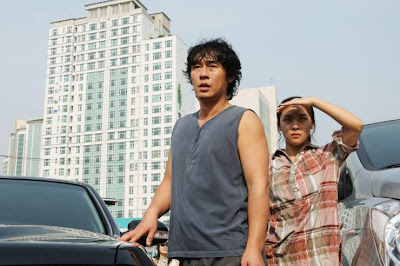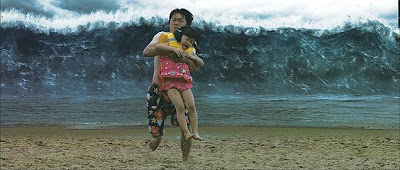.jpg)
35 Shots of Rum (35 rhums). 2008. Directed by Claire Denis. Written by Claire Denis and Jean-Pol Fargeau. Produced by Bruno Pesery. Cinematography by Agnes Godard. Edited by Guy Lecorne. Music by Tindersticks. Production design by Arnaud de Moleron. Costume design by Judy Shrewsbury. Sound by Martin Boissau, Christophe Winding, and Dominique Hennequin.
Cast: Alex Descas (Lionel), Mati Diop (Josephine), Gregoire Colin (Noe), Nicole Dogue (Gabrielle), Julieth Mars Toussaint (Rene).
One of the very best films you will see this year is Claire Denis' exquisitely rendered 35 Shots of Rum, now playing at Film Forum through September 29. Denis' latest film White Material, which returns her to the African setting of her debut Chocolat, will make its latest stop at this year's New York Film Festival, after its appearances in Venice and Toronto. So New Yorkers will have the opportunity this fall to be blessed with two new films by one of cinema's greatest living artists. Below is my review of 35 Shots of Rum, written when it screened at last year's Pusan International Film Festival.
Claire Denis’ gorgeous new film, 35 Shots of Rum, is as essentially plot-less as her previous feature, the globe-trotting philosophical treatise L’Intrus (The Intruder), but it is less experimental and more grounded in character and emotion. However, it is hardly less of a revelatory experience. The central relationship depicted in this film is that of Lionel (Alex Descas), a train operator living with his daughter Josephine (Mati Diop), in a working-class suburb of Paris. 35 Shots of Rum’s affinities with the works of Ozu, especially Late Spring, have been much remarked on by other commentators: the many shots and scenes that revolve around trains; the brief establishing shots between scenes analogous to Ozu’s “pillow shot” inserts; the delicacy with which unspoken aspects of intimate relationships are handled. The film’s central situation also recalls Ozu. Lionel, a taciturn widower, lives a quiet life with his daughter, and their deep love for one another is expressed through such gestures as one early scene in which Lionel buys a rice cooker for Josephine, who expresses great delight. The film is so patient about revealing the connections between its characters that it takes a bit of time before we realize that they are in fact father and daughter.
Two other characters also figure here: their neighbor Noe (Gregoire Colin), a rather eccentric young man who is attracted to Josephine, and Gabrielle (Nicole Dogue), Lionel’s ex-girlfriend who remains close to Lionel and Josephine, and seems to wish to rekindle her romance with Lionel, who in turn keeps her at arm’s length. Everything else in the film flows from this initial situation. But rather than imposing a dramatic plot, although almost any other filmmaker would have turned these potential conflicts into melodrama, Denis allows these characters to interact and lets their actions evolve organically. This is not to say that nothing happens in the film; actually, there is a definite progression that occurs, and it leads to a great deal of emotion. This occurs most significantly with what happens to Lionel’s colleague Rene (Julieth Mars Toussaint), who after being compelled to retire, finds himself adrift and unable to replace the order and sense of purpose that his job provided him.
The way in which Denis depicts the milieu of her film is quite extraordinary. The popular notion of the Parisian suburbs, many of which are inhabited by those of African and Arabic descent, is that of poor and angry people who every now and then erupt into riots against police and other authorities. The depiction of these neighborhoods in French films often plays upon these problems and concentrates on their conflicts with the larger French society. Denis, however, takes quite a different tack, concentrating much more on her characters as individuals rather than representatives of their race. These are ordinary working-class people who experience the normal joys and pains of anyone else, although presented here in an aesthetically beautiful way. Denis, to be sure, does not ignore a global perspective: she includes a key scene in which Josephine participates in a classroom debate about how African nations are adversely impacted by having to repay massive debts to Western nations. However, we are mostly immersed in the lives of the central characters, and it is always a pleasure to be in their company.
The loose structure of 35 Shots of Rum allows for some exquisitely lovely moments, most notably a key scene of the film in which Lionel, Josephine, Noe and Gabrielle all retreat into a bar during a rainstorm after their car breaks down on their way to a concert. Although the bar is already closed, the owner generously allows them shelter. A nearly wordless scene ensues, during which much occurs: Noe and Josephine’s relationship becomes subtly much more than a casual friendship; Lionel sees this happen, and tacitly accepts this despite his slight unease, while Lionel in turn acts upon his attraction to the statuesquely beautiful bar hostess, eventually spending the night with her. The four central characters dance to the tune of the Commodores’ song “Nightshift,” which is quite appropriate to the elegiac tone of much of this film. This is a beautifully choreographed and constructed scene, conveying everything through glances and gestures, and it is a great testament to Claire Denis’ prodigious artistry.
However, Denis is by no means a solo act. She has surrounded herself over the years with an ace group of collaborators who are essential partners in creating one of the great bodies of work in cinema. One of the most important members of her crew is Agnes Godard, one of the world’s greatest cinematographers, who seems incapable of composing a bad shot. She imbues all of the film’s environments with a textured, tactile quality that illuminates everything it touches. Denis’ regular screenwriting partner Jean-Pol Fargeau contributes greatly to a scenario that feels loosely improvisational yet exactingly precise at the same time. And of course, as always with Denis, much credit is due to the excellent cast she has assembled, which includes two Denis regulars: Alex Descas, a ruggedly handsome man who imparts tremendous gravity and great emotion to his role; and Gregoire Colin, who goes far beyond the quirks of his character to deliver a very poignant performance. Newcomer Mati Diop also impresses as the daughter who is protective of her father almost to his detriment (much like the typical Ozu heroine usually played by Setsuko Hara). Nicole Dogue skillfully expresses her character’s sense of regret over her life decisions, and her wish to have to same closeness with Lionel that his daughter enjoys. In every gesture and action Denis’ ensemble cast radiates a deep beauty that makes watching them a joyful experience.
35 Shots of Rum, along with Beau Travail and L’Intrus, is one of Denis’ greatest works, conveying the ebbs and flows of life with uncommon sensitivity. And by the time Lionel partakes of the titular drinks, an act that signifies his philosophy of life, one begins to wish one could spend many more hours in the endlessly fascinating world of this film.
35 Shots of Rum is at Film Forum through September 29. Click here to purchase tickets.
.jpg)
.jpg) The premise of Haeundae is that a massive tsunami, on the order of the one that hit
The premise of Haeundae is that a massive tsunami, on the order of the one that hit .jpg) For a film that successfully marries its behemoth budget with a smart, politically acute, and genuinely heartfelt story, look no further than the current all-time Korean box-office champ,
For a film that successfully marries its behemoth budget with a smart, politically acute, and genuinely heartfelt story, look no further than the current all-time Korean box-office champ, .jpg)






